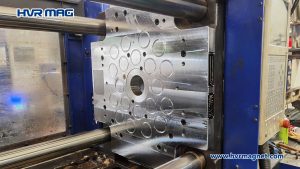
In the realm of injection molding, the efficiency and reliability of magnetic mold clamping systems are paramount. However, like any machinery, they can encounter challenges, particularly when mold temperatures soar beyond the recommended thresholds. When faced with excessively high mold temperatures, the magnetic clamping systems can experience issues such as sliding between the dynamic and static molds, triggering alarms on the control panel, and halting the automatic operation of the injection molding machine.
To mitigate the impact of high mold temperatures on magnetic clamping systems, several steps can be taken:
Alert Mechanism: The first line of defense is the alert mechanism integrated into the system. When the temperature exceeds the safe operating range, the system promptly notifies operators through illuminated status alarm indicators on the control panel. This serves as an early warning system, prompting immediate action to prevent further complications.
Switch to Mold Changing Mode: Upon detection of high mold temperature and consequent sliding between molds, the control system will swiftly switch the system to mold changing mode. By doing so, operators can assess the situation, address the root cause, and take corrective measures before resuming production.
Re-magnetization: After transitioning to mold changing mode, it is imperative to re-magnetize the system. Re-magnetization restores the magnetic force between the molds, ensuring proper alignment and stability during the molding process. This step is essential for preventing further issues related to mold misalignment or instability.
Cooling Shutdown: In cases where the mold temperature surpasses the safety threshold, it is advisable to initiate a cooling shutdown. This involves stopping the injection molding machine to allow the system to cool down gradually. By giving the system sufficient time to dissipate heat, operators can safeguard against potential damage to the magnetic clamping components and ensure the longevity of the equipment.
Resumption of Operations: Once the temperature has been brought back within the safe operating range and any underlying issues have been addressed, the system can be restarted. However, it is crucial to perform a thorough inspection to verify that the system is functioning optimally before resuming production. This includes checking for any signs of wear or damage to the magnetic clamping components and conducting preventive maintenance as necessary.
In conclusion, addressing high mold temperature in a magnetic mold clamping system requires a systematic and proactive approach to ensure the safety, efficiency, and reliability of the injection molding process. You can also purchase heat resisting type of magnetic mold clamping system to avoid this problem. For more information, please contact HVR MAG at export@hvrmagnet.com






